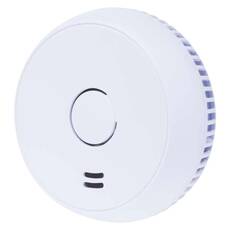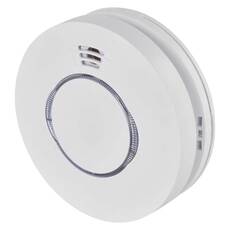Smoke Alarm
Smoke in the home is never a good thing. Whether it reminds us of a pot left on the stove, a candle left burning or an iron left on. Unfortunately, smoke quickly turns to flames, which in turn can be a great danger to our physical safety. Read more...
• Signalling volume: >85 dB at a distance of 3 m
• Power supply: 1× 9 V, included
• Mounting type: wall-mounted or free-standing
• Operating temperature: 0 °C to 40 °C
• Operating humidity: 5 to 95
• Signal type: optical and audible
• Lifetime: 10 years
• Dimensions: 90 × 33 mm
• Signalling volume: >85 dB at a distance of 3 m
• Power supply: 230 V mains, backup battery: 1 pc 9 V battery included
• Mounting type: wall-mounted or free-standing
• Operating temperature: 0 °C to 40 °C
• Operating humidity: 0-93 %
• Signal type: optical and audible
• Lifetime: 10 years
• Dimensions: 45 × 140 × 140 mm
• Signalling volume: >85 dB at a distance of 3 m
• Protection: IP20
• Power supply: 2× 1.5 V AA, included
• Transmission frequency: 2.4 GHz Wi-Fi
• Supported: Android, IOS
• Compatibility: EMOS GoSmart, Tuya, Lidl, Smartlife, open system
• Mobile notification
• Mounting type: wall-mounted or free-standing
• Operating temperature: 0 °C to 40 °C
• Operating humidity: 0-93%
• Signal type: optical and audio
• Lifetime: 10 years
• Dimensions: 38 × 120 × 120 mm
Who is a smoke alarm useful for?
According to figures from the German Federal Disaster Management Agency, there were 55,000 house fires in our country last year. This means that in 2023, firefighters were alerted to 150 house fires a day. This is a very high number. If smoke alarms had been installed in these apartments and family houses, the vast majority of these fires would certainly not have happened.
But it is not only in homes that smoke alarms should be installed, but also in commercial premises or industrial facilities. So the answer to the question in the subtitle is very simple: everyone.
Should we choose a fire alarm or a smoke alarm, or a combination device?
It is already clear from the title that there are smoke alarms, fire alarms and combination detectors, but the question here is how do these devices differ from each other? A smoke detector, as the name suggests, detects the presence of smoke in the air.
It goes without saying that smoke is the first sign of fire. So, if you get a signal at this stage, you have a better chance of avoiding damage to your health and property if you are inattentive or if an appliance fails. Why? Because as the concentration of smoke in the air increases, the smoke alarm is activated and immediately sounds. This allows us to take immediate action and extinguish the fire while it is still in its early stages.
Fire alarms, on the other hand, detect a rise in temperature and the appearance of flames. This also means that while smoke alarms warn of the early stages of the danger, fire alarms warn of the later stages. But the fire alarms not only signal, they also activate the sprinkler system, which is connected to the alarm system, after a short time.
What are the disadvantages of a smoke detector?
Some smoke alarms are unfortunately sensitive to humidity and dust. In these cases, they generate false alarms, which can be both annoying and even cause serious problems.
How does a smoke alarm work?
Smoke alarms available from the DND Telekom webshop are so-called optical smoke detectors that work on the principle of scattered light. This means that the device only reacts if it detects a sufficient concentration of smoke. This also means that it will not give an audible or visual alarm for low concentrations of smoke, i.e. if it detects only the slight smoke of a cigarette.
The smoke detector contains an infrared light-emitting diode and a so-called photodiode. This allows it to emit light beams on a regular test basis. If smoke particles are released into the air and appear in the optical field of view of the detector, the infrared light beams emitted by the device will hit these particles and reflect them back. This triggers the device and the Emos smoke detectors emit an audible and optical signal.
Where should we place the smoke alarm?
For rooms with a normal floor area, it is best to place the smoke alarm in the geometric centre of the ceiling. In smaller rooms, you might consider mounting the device on the wall. In this case, mount it 50 cm from the ceiling. But make sure that the furniture in the room is at least 1 metre away from the unit.
If you want to install a smoke detector in a corridor, you should ensure that the width of the corridor does not exceed 3 metres, so that the smoke detector is 15 metres from the adjacent room and 7.5 metres from the end of the corridor. But what is the rule if you want to install such a device in a larger room? These devices have a range of around 6 metres in diameter, so you need to position them so that they cover all corners of the room.
What should we look out for when maintaining smoke alarms?
As mentioned above, smoke alarms are prone to false alarms. This can also be caused by insects, and sometimes even by insects moving into the device. This is why regular maintenance of the devices is important. Once smoke alarms are installed, they should be checked at least once a year. All smoke alarms have a test button which you should press until it sounds. When the button is released, the alarm should also stop.
If it doesn't, you should check the device immediately, but also make sure the batteries are not dead. When carrying out maintenance, remember to remove any dust or other dirt from the opening of the appliance.




